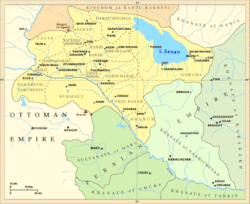This is an old revision of this page, as edited by Grandmaster (talk | contribs) at 10:54, 3 February 2009 (→History). The present address (URL) is a permanent link to this revision, which may differ significantly from the current revision.
Revision as of 10:54, 3 February 2009 by Grandmaster (talk | contribs) (→History)(diff) ← Previous revision | Latest revision (diff) | Newer revision → (diff)| Khanate of Nakhichevan | |
|---|---|
| 1604–1828 | |
 "Yerevan Khanate c. 1800." "Yerevan Khanate c. 1800." | |
| Status | khanate |
| Capital | Nakhichevan |
| History | |
| • Established | 1604 |
| • Disestablished | 1828 |
The Khanate of Nakhichevan (Template:Lang-az; Template:Lang-fa) was a feudal state in the southern Caucasus, nominally subordinate to the Persian Shahs, and named after its chief settlement, the town of Nakhichivan. Its territory mostly corresponded to the present-day Nakhchivan Autonomous Republic, and central parts of present-day Armenia.
As a result of the Persian defeat in the last Russo-Persian War, it was ceded to the Russian Empire in accordance with the Treaty of Turkmenchay. Immediately following this, the territories of the former Khanate of Erevan and Nakhichevan were joined to form the Armenian oblast, which was later abolished, and the territory of khanate was included in Nakhichevan uyezd of Erivan Governorate.
History
Initially the territory of Nakhichevan was part of Čoḵūr Saʿd, but later came to be ruled by a separate khan. Shortly after the capture of Erevan in 1604, Shah Abbas I appointed Maqsud Sultan, a leader of a Turkic tribe named Kangarlu, described by J. M. Jouannin as “a small tribe established in Persian Armenia," as governor of Nakhichevan. Later that year, Ottoman forces threatened the area, Shah Abbas ordered Maqsud Sultan to evacuate the entire population of the Nakhchivan region (including the Armenians of Julfa, who, in the following year, were transplanted to Isfahan) to Qaraja Dag (Arasbaran) and Dezmar.
During the Russo-Persian War of 1804-1813, in 1808 Russian forces under general Gudovich briefly occupied Nakhichevan, but as a result of the Treaty of Gulistan it was returned to Persian control.
During the second Russian-Persian war Abbasabad, a fortress of special strategic importance for the defense of the Nakhchivan khanate was betrayed to the Russians. In 1827 Abbas Mirza entrusted the stronghold to Ehsan Khan Kangarlu, of a local family of dubious loyalty to the Qajars. After heavy losses in an attempt to take the fortress by escalade on July 14, the Russians mounted a siege. Ehsan Khan secretly contacted the Russian commander, General Paskevich, and opened the gates of the fortress to him on 27 Ḏu’l-ḥejja 1242/22 July 1827. With the fall of Abbasabad, Nakhchivan became a Russian province and Ehsan Khan was rewarded with the governorship, conferred the rank of major-general of the Russian army and the title of campaign ataman of the Kangarly militia.
Khans of Nakhichevan in the Russian empire
After the dissolution, the khans of Nakhichevan became known in the Russian empire by the surname Khan Nakhichevanski, and the men of this family traditionally entered military service. Six Khans Nakhchivanski became generals in the Russian tsarist, Soviet and Iranian armies. Two sons of Ehsan khan - Ismail khan and Kalbali khan - were generals in the Russian army and were awarded orders of Saint-George IV degree for their actions in battle. A son of Kalbali khan, Huseyn Khan Nakhichevanski, was a prominent Russian military commander and adjutant general of the Russian Emperor, and his nephews, Jamshid and Kalbali, were generals in the Soviet and Iranian armies respectively.
Rulers
- 1747-1787 Haydar Quli Khan
- 1787-1823 Kalb` Ali Khan
- 1823-1828 Ehsan Khan
- 1828-1834 Karim Khan Kangarli
Notes
- Hewsen, Robert H. Armenia: a Historical Atlas. Chicago, IL: University of Chicago Press, 2001, map 149.
- Oberling, P. "ĀYRĪMLŪ". Encyclopedia Iranica. Retrieved 2009-02-1.
{{cite web}}: Check date values in:|accessdate=(help) - Tadeusz Swietochowski. Russian Azerbaijan, 1905-1920: The Shaping of National Identity in a Muslim Community. Cambridge, UK, Cambridge University Press, 2004. ISBN:0521522455
- Bournoutian, George A. (1992). The Khanate of Erevan Under Qajar Rule, 1795-1828. p. 32.
- ^ Oberling, P. "Kangarlu". Encyclopedia Iranica. Retrieved 2009-02-1.
{{cite web}}: Check date values in:|accessdate=(help) - ^ Ekbal, Kamran. "ʿAbbāsābād (2)". Encyclopedia Iranica. Retrieved 2009-02-1.
{{cite web}}: Check date values in:|accessdate=(help) - Template:Ru icon Иванов Р. Н. Именем Союза Советских… Жизнь и гибель комбрига Нахичеванского. — М.: Герои Отечества, 2007.
- Azerbaijan
